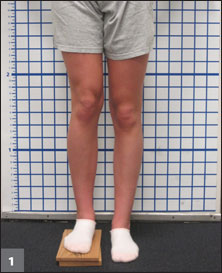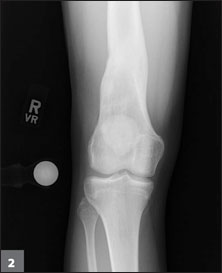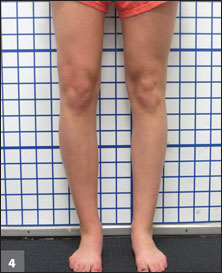Distal femoral osteotomy: Short-term deformity solution needs long-term follow-up
Orthopedic surgeons who treat pediatric patients may perform a distal femoral osteotomy when a congenital lower limb deformity is present or to treat several other conditions.
“A distal femoral osteotomy is great because it allows us to do 3-D correction,” Coleen S. Sabatini, MD, MPH, chief of the Division of Orthopedic Surgery at UCSF Benioff Children’s Hospital Oakland, Calif., told Orthopedics Today. “We can use it for children with fixed flexion deformities of their knee, to correct varus and valgus malalignments of the distal femur and to correct rotational deformities of the limb.”
As congenital deformity is not the only indication for distal femoral osteotomy, it is difficult to say how often distal femoral osteotomy is performed in pediatric patients.

Image: Tingle C, Orthopedics Today
“It is difficult to give an exact number [of patients] because the conditions and diagnoses for which [distal femoral osteotomy] is performed are varied, but overall I would say it is a common procedure,” Dorothy Y. Harris, MD, pediatric orthopedic surgeon at Texas Children’s Hospital in Houston, told Orthopedics Today.
Orthopedics Today spoke with pediatric orthopedic surgeons about the indications for distal femoral osteotomy, the associated complications of which surgeons should be aware and the postoperative management of children who undergo a distal femoral osteotomy.
Various indications
In addition to deformity correction, distal femoral osteotomy can be used to correct a growth plate injury or fix a fracture that has not healed in the right position, S. Robert Rozbruch, MD, chief of the Limb Lengthening and Complex Reconstruction Service at Hospital for Special Surgery in New York City, said.
“Sometimes, kids will have an injury. They will damage the growth plate [and] because of that the bone will be short and it will be crooked,” Rozbruch told Orthopedics Today. “In a case like that, we will do a distal femoral osteotomy to correct deformity,” said Rozbruch, who is also professor of clinical surgery at Weill Cornell Medical College at Cornell University.
Limb length inequality, which may accompany deformity, also can be corrected during the distal femoral osteotomy, Rozbruch said.
“Lengthening can be done simultaneously with the deformity correction and that is all done through the same osteotomy, in most cases,” he said.
Gait correction in cerebral palsy

Distal femoral osteotomy is also largely performed in pediatric patients with neuromuscular disorders, such as cerebral palsy (CP), myelomeningocele and skeletal dysplasia. Patients with osteogenesis imperfecta (OI) or arthrogryposis are also amenable to treatment with this type of osteotomy, according to the orthopedic surgeons interviewed.
“One of the more common reasons [distal femoral osteotomy] is performed in cerebral palsy is for the presence of a crouched gait and the technique is called a distal femoral extension osteotomy,” Harris said. “In particular, it is used to treat the persistent flexion that occurs about the knee in patients with crouched gait who have cerebral palsy. It leads to less flexion during both stance and swing when patients with cerebral palsy are ambulating,” she said.
For severe deformity
Distal femoral osteotomy, however, is usually indicated for children around adolescent age who do not have a lot of growth left, according to Rozbruch.
Shital N. Parikh, MD, associate professor of orthopedic surgery at Cincinnati Children’s Hospital Medical Center and a member of the Orthopedics Today Editorial Board, said the procedure is reserved for pediatric patients with severe deformities.
“Osteotomy is usually indicated for patients when their deformity is more than 10° when compared to where the normal alignment should be,” Parikh told Orthopedics Today.

Guided growth option
For patients who are skeletally immature, instead of treating their deformity with distal femoral osteotomy, surgeons may decide to use the guided growth method, which temporarily stops growth on one side of the growth plate to allow for deformity correction.
“If there is a valgus deformity, we stop the growth medially, allow the growth to continue to occur laterally and allow the leg to grow straight using this principle of guided growth and that usually is a small plate and screws on the inside or outside [of the distal femur],” Lawrence Wells, MD, associate professor of orthopedic surgery at the Pearlman School of Medicine at the University of Pennsylvania, told Orthopedics Today. “If it is a varus deformity, [then] the plate would be placed on the outside of the distal femur. If it is a valgus deformity, the plate would be placed on the inside of the distal femur to try and employ guided growth.”
Guided growth can improve the gait of patients with CP who are skeletally immature, Pooya Hosseinzadeh, MD, assistant professor of orthopedic surgery at Washington University School of Medicine, said.
“As long as the child is skeletally immature and has more than 2 years of growth left, [gait improvement] can be done by guided growth of the anterior part of the growth plate of the distal femur by putting hemiepiphysiodesis plates on the front of the knee,” Hosseinzadeh, who also practices at Shriners Hospital for Children and St. Louis Children’s Hospital, said.

Hamstring lengthening is an alternative surgical treatment for patients with crouched gait, according to Harris. She said alternative non-surgical treatments for children with CP include tone management through oral medication, Botox injections or intrathecal baclofen pumps used prior to the development of fixed contracture.
According to Rozbruch, patients who have less significant leg length discrepancies may undergo epiphysiodesis, where the contralateral leg is shortened to correct the discrepancy.
Pediatric vs adult patients
Depending on the skeletal maturity of the pediatric patient, the distal femoral osteotomy procedure performed may be similar to that used in an adult.
“In skeletally mature patients, the implants are basically the same as for adults,” Harris said, which usually included using some type of plate fixation, she noted.
Intramedullary nails can be used, as well, but the implant selection is based on how distal the osteotomy will be in the femur, according to Harris.
“In young children, [we] just do not have plate fixation available. We can do that with either K-wires or Steinmann pins, especially for temporary fixation,” she said.
As the fixation for a distal femoral osteotomy performed in a skeletally mature adolescent is similar to what is used in adults, Wells said adult reconstructive or trauma surgeons can easily perform the procedure in younger patients. However, in the case of a skeletally immature patient, he said an adult reconstructive or trauma surgeon would need to be particularly careful not to damage the patient’s growth plate.
“In an adult patient, we do not have to worry about the growth plate because it is no longer there, but in pediatric patients, we have to be concerned about the growth plate and be respectful of the growth plate as we plan our osteotomy and our treatment,” Wells, who is also an attending orthopedic surgeon at Children’s Hospital of Philadelphia and an Orthopedics Today Editorial Board member, said. “An adult surgeon could do [the surgery] if he or she is cognizant of the growth plate [and] knows how to manage that.”
Special circumstances

Pediatric patients with rarer underlying conditions, such as OI or CP, should be treated by a pediatric surgeon who has the knowledge and familiarity that comes with treating the condition regularly, according to Harris.




Parikh noted distal femoral osteotomy in pediatric patients may need specialized implants as adult implants could be too big or too rigid for a child and can lead to nonunion or delayed healing.
“Kids are not small adults. Their bones are smaller and softer, their joints are more lax. [Surgeons] should be concerned about [staying] away from the growth plate and not [causing] any injury to the growth plate,” Parikh said. “It is a surgical technique issue. But, the other issue would be that you cannot use adult-type implants on kids. You need special implants,” he said.
However, adult-focused orthopedic surgeons should be aware of and willing to perform the comprehensive care that pediatric patients require if they are going to operate on children and adolescents, Sabatini noted.
“The surgical care of the patient is more than the surgery itself, and we must ensure we are focused on the comprehensive care of the pediatric patient throughout the perioperative period, including giving support to the family,” she said.
Complications can occur
As with any surgery, infection is a surgical risk, Wells said.
Sabatini said wound healing can be of concern after distal femoral osteotomy, particularly in children with nutritional deficiencies, as with any orthopedic procedure.
“Besides the usual complications of bleeding and infection that can happen in any surgery, the complication for this would be loss of fixation if there is over[-treatment] or under-treatment of the deformity during the procedure,” Hosseinzadeh said.
Surgeons should also keep an eye on the knee joint after surgery. It may become progressively stiffer or there may be signs of joint space narrowing.
Older children or children with nutritional deficiencies may experience delayed union or nonunion of the osteotomy, Sabatini said.
Complications with distal femoral osteotomy can also include significant postoperative swelling in patients who underwent acute correction for deformities of a large magnitude. This may lead to compartment syndrome, although this is rare, according to Harris.
Another postoperative complication to be aware of is growth disturbance, such as limb length inequality, Wells said.
During the osteotomy, there is a risk of directly injuring the nerves or vascular structures in the area of the operation, according to Harris. Furthermore, “There is always a risk of creating a fracture in a place that you did not want to and, certainly in kids, there is always the risk of injuring the physis when we are operating around it.”

Hosseinzadeh noted there is the risk of stretching the neurovascular bundle behind the knee in children with CP.
He said, “If there is an acute correction and the knee is stretched right after the procedure, that can put the nerve in stretch and that can usually present with numbness and tingling in the foot.”
According to Sabatini, “There is the risk of recurrence or malalignment following distal femoral osteotomy in pediatric patients. Therefore, patients should be followed through skeletal maturity. This follow-up for years after surgery requires a commitment from both us, as surgeons, and the patients and families. It is important for people to know this is a surgery that happens in an acute period of time, but that we do follow [patients] for years afterward.”
Pain management, follow-up
Surgeons should focus on several principles and goals in the postoperative management of pediatric patients who undergo a distal femoral osteotomy, according to Wells.
“The general principles and goals are to, number one, control pain; number two, to try and regain knee motion as soon as possible — functional knee range of motion. That means full extension of the knee, have the ability of the knee to be fully extended and then, secondarily, have the knee have the ability to flex all the way. Typically, for a pediatric person, that is at least flexing 130° or flexing to the same degree as the contralateral side can flex,” Wells said.
To help manage the pain associated with the surgical procedure, Sabatini suggests multimodal pain control with injection of local or regional anesthetic at the time of surgery and a scheduled non-narcotic pain reliever, with the addition of a PRN narcotic pain medication postoperatively when necessary.
“It is important to facilitate proper communication between the patient, the patient’s family and our team of nurses and physicians to ensure the child’s pain is being addressed and managed appropriately,” she said.
Sources told Orthopedics Today epidural catheters may be used in patients who are undergoing concomitant surgeries, such as a bilateral distal femoral osteotomy.
“If distal femoral osteotomy is done in addition to other procedures, what we call a singular and multi-level osteotomy, in children with cerebral palsy, epidural catheters can be helpful in the first 48 [hours] to 72 hours,” Hosseinzadeh said.
However, Parikh said surgeons should be careful to not completely mask the patient’s pain, especially when larger corrections are performed, because these patients are prone to nerve injuries and compartment syndrome following osteotomy.
Physical therapy, bracing
Prior to weight-bearing, Harris’ patients undergo a period of physical therapy that involves gentle passive and active range of motion of the knee joint to prevent stiffness.

Images: Parikh SN
“Following the weight-bearing restrictions being lifted, there is formal physical therapy for relearning weight-bearing and again strengthening the muscles since there has been that period of non-weight-bearing,” she said.
Parikh noted patients in the adolescent age group who are braced postoperatively begin physical therapy earlier than younger patients, who are typically placed in a split cast postoperatively.
Wells said patients can usually begin to weight-bear with crutches within 4 weeks to 6 weeks of surgery.
However, Sabatini said, “The time to weight-bearing and the acceleration of it depend on several factors, including stability of construct, fixation method, surgeon preference and the patient’s ability to comply with weight-bearing restrictions.”
She noted, “We sometimes err on the side of non-weight-bearing because many kids cannot limit themselves.”
Research into lengthening rods
Rozbruch said future research should explore whether a lengthening rod used for the same indications can be placed through the patient’s growth plate without damaging it.
“If you are doing a distal femoral osteotomy and you are trying to lengthen, that rod is going to go in from the distal femur and it is going to go across the growth plate,” he said. “Now, we shy away from doing that for the most part because we do not want to damage the growth plate. But, it may be that if you make a single passage through the growth plate and if you prevent bone from bridging across the growth plate, that it is not going to impede future growth.”
Parikh would like to see some research focus on whether the growth plate can be stimulated to grow faster.
“Right now, we know by growth modulation, we can stop the growth on one side, but we do not know if there is a way to, instead of stopping growth on one side, [stimulate] the growth on one side,” Parikh said.
Rozbruch noted that research that predicts the rate of recurrence of deformity after distal femoral osteotomy in the skeletally immature patient is also warranted.
Harris noted that more long-term studies are needed to show whether certain distal femoral osteotomy techniques actually decrease the rate of degenerative joint disease in skeletally mature patients.
“For our skeletally mature patients with varus and valgus deformities, especially as it relates to distal femoral osteotomies, some of the newer techniques, including an opening-wedge osteotomy, long-term papers show follow-up after 7 [years] to 10 years has not been done and so we do not truly know whether performing these decrease the rate of degenerative joint disease that [orthopedists] may have seen in patients who did not get treated,” she said.

Research into patients with CP who undergo distal femoral extension osteotomies is focused on defining the best candidates for that procedure compared to hamstring lengthening or guided growth, Harris said.
“There certainly is some research that is being done or has been done, but we still have not necessarily figured out the exact indications and the ideal patient yet,” she said. – by Casey Tingle
- For more information:
- Dorothy Y. Harris, MD, can be reached at Texas Children’s Hospital, 6701 Fannin St., 8th Fl., Houston, TX 77030; email: dyharris1@texaschildrens.org.
- Pooya Hosseinzadeh, MD, can be reached at St. Louis Children’s Hospital, 4S60, Suite 1B, 1 Children’s Pl., St. Louis, MO 63110; email: hosseinzadehp@wudosis.wustl.edu.
- Shital N. Parikh, MD, can be reached at Cincinnati Children’s Hospital Medical Center, 3333 Burnet Ave., Cincinnati, OH 45229; email: shital.parikh@cchmc.org.
- S. Robert Rozbruch, MD, can be reached at Hospital for Special Surgery, 535 East 70th St., New York, NY 10021; email: rozbruchsr@hss.edu.
- Coleen S. Sabatini, MD, MPH, can be reached at UCSF Benioff Children’s Hospital Oakland, 747 52nd St., Oakland, CA 94609; email: coleen.sabatini@ucsf.org.
- Lawrence Wells, MD, can be reached at Children’s Hospital of Philadelphia, 3401 Civic Center Blvd., Philadelphia, PA 19104; email: wellsl@email.chop.edu.
Disclosures: Rozbruch reports he is a consultant for NuVasive, Smith & Nephew and Stryker. Harris, Hosseinzadeh, Parikh, Sabatini and Wells report no relevant financial disclosures.
Click here to read the ![]() , “Under what circumstances should hardware be removed following pediatric distal femoral osteotomy?”
, “Under what circumstances should hardware be removed following pediatric distal femoral osteotomy?”
